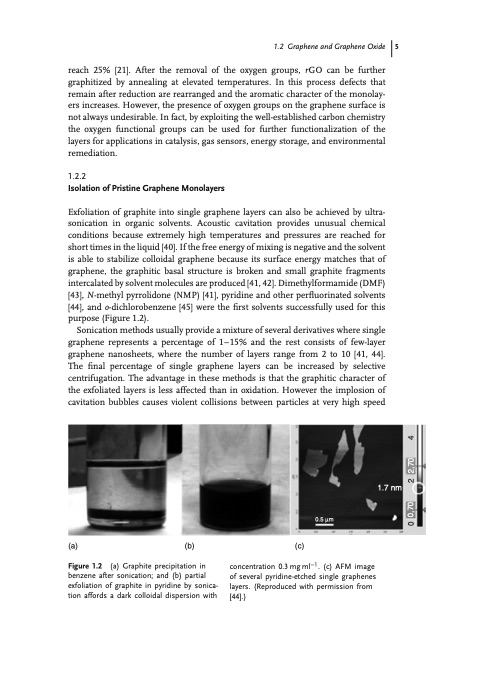
PDF Publication Title:
Text from PDF Page: 005
reach 25% [21]. After the removal of the oxygen groups, rGO can be further graphitized by annealing at elevated temperatures. In this process defects that remain after reduction are rearranged and the aromatic character of the monolay- ers increases. However, the presence of oxygen groups on the graphene surface is not always undesirable. In fact, by exploiting the well-established carbon chemistry the oxygen functional groups can be used for further functionalization of the layers for applications in catalysis, gas sensors, energy storage, and environmental remediation. 1.2.2 Isolation of Pristine Graphene Monolayers Exfoliation of graphite into single graphene layers can also be achieved by ultra- sonication in organic solvents. Acoustic cavitation provides unusual chemical conditions because extremely high temperatures and pressures are reached for short times in the liquid [40]. If the free energy of mixing is negative and the solvent is able to stabilize colloidal graphene because its surface energy matches that of graphene, the graphitic basal structure is broken and small graphite fragments intercalated by solvent molecules are produced [41, 42]. Dimethylformamide (DMF) [43], N-methyl pyrrolidone (NMP) [41], pyridine and other perfluorinated solvents [44], and o-dichlorobenzene [45] were the first solvents successfully used for this purpose (Figure 1.2). Sonication methods usually provide a mixture of several derivatives where single graphene represents a percentage of 1–15% and the rest consists of few-layer graphene nanosheets, where the number of layers range from 2 to 10 [41, 44]. The final percentage of single graphene layers can be increased by selective centrifugation. The advantage in these methods is that the graphitic character of the exfoliated layers is less affected than in oxidation. However the implosion of cavitation bubbles causes violent collisions between particles at very high speed (a) (b) Figure 1.2 (a) Graphite precipitation in benzene after sonication; and (b) partial exfoliation of graphite in pyridine by sonica- tion affords a dark colloidal dispersion with 0.5 μm concentration 0.3mgml−1. (c) AFM image of several pyridine-etched single graphenes layers. (Reproduced with permission from [44].) 1.2 Graphene and Graphene Oxide 5 (c) 1.7 nm 0 0,70 2 2,70 4PDF Image | An Introduction to Graphene

PDF Search Title:
An Introduction to GrapheneOriginal File Name Searched:
352733551X-c01.pdfDIY PDF Search: Google It | Yahoo | Bing
Salgenx Redox Flow Battery Technology: Power up your energy storage game with Salgenx Salt Water Battery. With its advanced technology, the flow battery provides reliable, scalable, and sustainable energy storage for utility-scale projects. Upgrade to a Salgenx flow battery today and take control of your energy future.
| CONTACT TEL: 608-238-6001 Email: greg@infinityturbine.com | RSS | AMP |